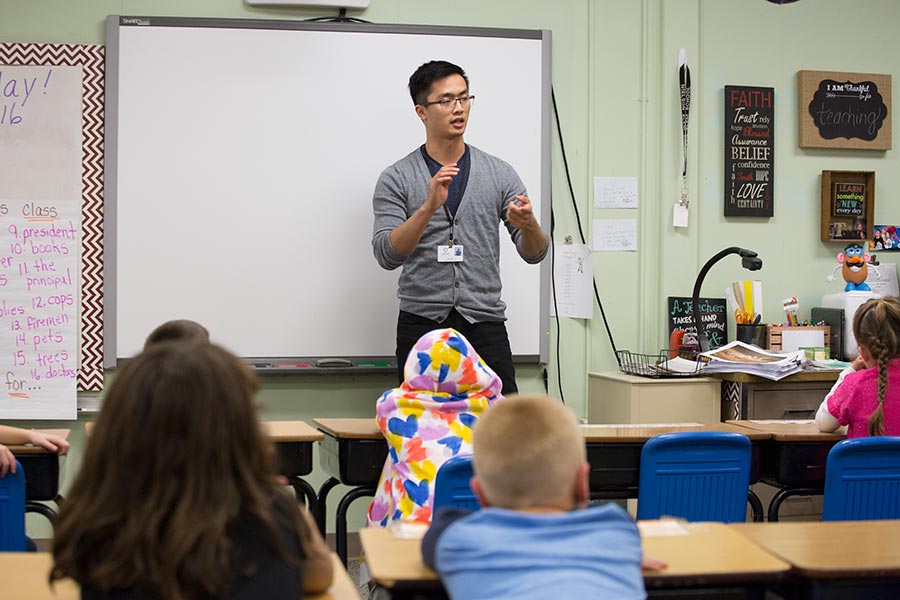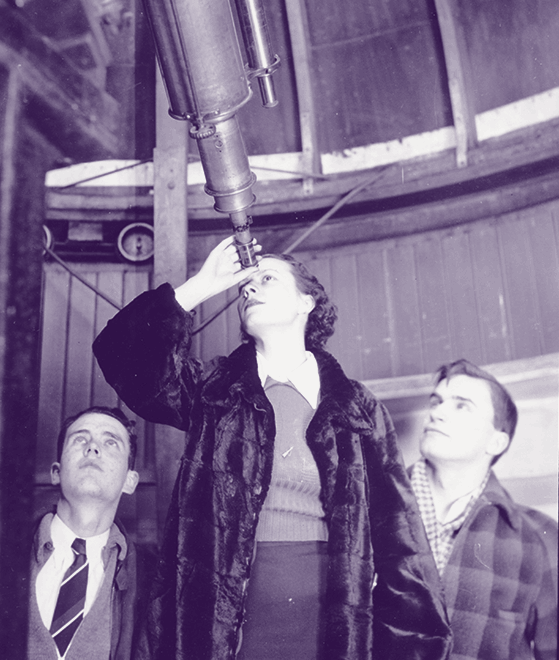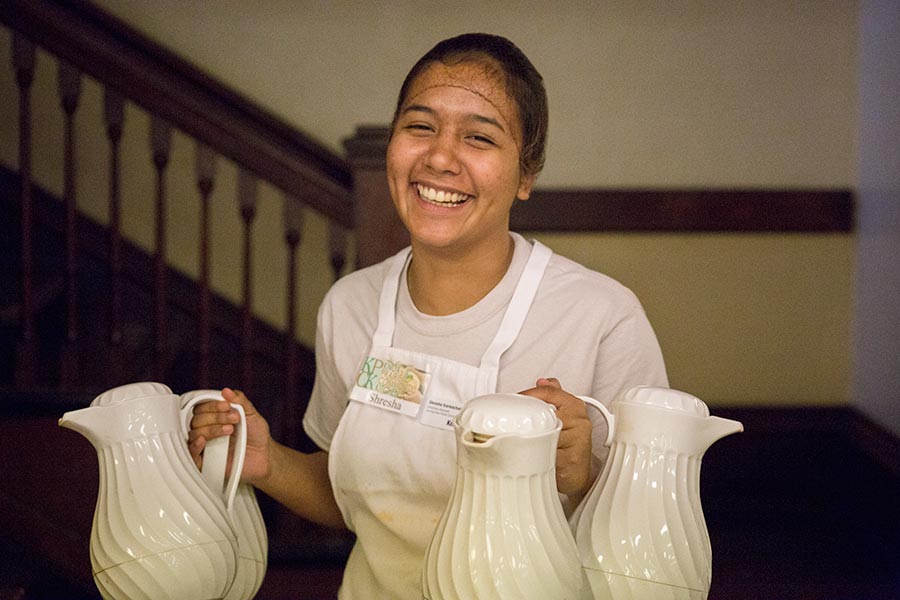

KnoxCorps: 5 Years Later
by Peter Bailley '74
The only thing worse than having to give a talk on a sensitive health-related topic to a room full of strangers, is when the room is full of fidgety second-graders.
"I'd never taught a class before, much less 30 grade school students," says Samuel Chen '16, a KnoxCorps Fellow assigned by the Knox County Health Department to give show-and-tell lessons on head lice to audiences.
"It didn't take me long to realize that I could not approach teaching in schools the same way that I did with scientific presentations in college." Instead, Chen hands out coloring books that he drew himself. Remy the Dragon makes hygiene fun for kids, instead of a parental diktat.
Chen is one of eight Knox students sent out into the Galesburg community this year through KnoxCorps—more than 50 in all since the program was unveiled five years ago by President Teresa Amott.
Placing students in long-term positions as key members of the organization's staff, KnoxCorps would showcase "new ways of civic engagement in local communities," Amott said, announcing the initiative in her 2012 installation address.
"Wait a minute," one might have wondered, sitting on the South Lawn of Old Main on a sunny day in May. "I thought Knox was doing well in community service." After all, in the years preceding KnoxCorps, Knox students were annually contributing thousands of volunteer hours in the community and raising thousands of dollars for local and national charities. Knox had been named to the President's Higher Education Community Service Honor Roll and was listed among the top 100 liberal arts colleges in Washington Monthly's annual "service oriented" rankings.
Serves You Right
"What makes KnoxCorps different is the depth of the commitment between the KnoxCorps member and participating organization. KnoxCorps Fellows and Associates bring their own initiative and interest to the experience in order to help the organizations fulfill their missions," says President Teresa Amott. "I wanted to launch a program that would honor the unique place that is Galesburg, Illinois, and create a stronger sense of belonging and contributions to the community."
There were some in the audience that day who immediately recognized that KnoxCorps really was new and different—and an opportunity to serve. "I was in the choir, so I was right up by the stage," recalls Josh HosmerQuint '13. "President Amott made the announcement that KnoxCorps was starting, and there would be a call for employment."
Hosmer-Quint applied immediately and was accepted into the first cohort. Starting that fall, he served for two academic years—first, as a KnoxCorps Associate with the Galesburg Downtown Council, eight hours a week while still taking classes in his senior year. Then, after graduating, he was a KnoxCorps Fellow with the Galesburg Convention and Visitors Bureau—20 hours a week for 10 months.
Fellows will say it's a chance to give back to Galesburg before their next post-graduate step. For some Fellows, their KnoxCorps year is truly a "gap" year before graduate school or full-time employment—a chance to make a difference in the community they have called home for four years.
"We really expected that most students would move through the program in linear fashion, like Josh did," explains the program's current administrator Karrie Heartlein. "We anticipated that students would move from Associate to Fellow. What we didn't anticipate was igniting a spark that grew so quickly into a flame. Students were truly hungry to make a difference. Several student Associates graduated and went immediately into Americorps programs such as City Year and VISTA."
Corps Values
When Amott arrived at Knox, she found others who were ready to help the College move to the next level in College-community engagement.
Already living in Galesburg were Gary Funk and his wife, Jana, whose daughter, Megan, had come to Knox in 2008. Gary was directing the Center for Midwestern Initiatives (CMA), a nonprofit organization affiliated with the Rural School and Community Trust, where Gary had previously spent two years as a Senior Fellow.
"We hired a team of Knox students to do community work for the CMI," Funk says. "Teresa Amott, Josh Gibb (of the Galesburg Community Foundation), and I all worked out the details of what would become KnoxCorps. It was both fun and exciting."
More than the vision of a person or a committee, KnoxCorps is a value shared with students themselves; nearly half of this year's entering class came to Knox already having engaged in significant community service.
"President Amott talked about how students would be directly helping a local organization," recalls Bridget Doherty '16, who was a first-year from Oak Brook, Illinois at the time of Amott's 2012 installation address. "I joined KnoxCorps because I'd worked with the Empty Bowls project in high school. Local artists and potters donated handmade bowls and local restaurants donated soup, and they raised money for local food charities. I came to Knox with a strong belief in bettering every community I live in."
What Every Community Needs
There's another reason why, in the spring of his junior year, Hosmer-Quint was ready to jump into KnoxCorps: "I was already part of the Peace Corps Prep program, and KnoxCorps seemed like a great chance to get experience in that kind of work."
Knox graduates have been among the Peace Corps' most enthusiastic volunteers, and it's no surprise that, when it came time for Knox to create its own signature service program, KnoxCorps would find the need and opportunity closest to home.
As Amott stated in her installation address, KnoxCorps would help answer the challenge: "How can we build bridges to our local Galesburg community across differences of age, color, and socioeconomic class?"
For the past quarter-century, the Galesburg community has been shedding both population and financial resources. Several major employers have moved or closed, and the median annual household income in Knox County is under $40,000—lower than both state and national figures. Half of Galesburg's public school pupils are classified as "economically disadvantaged.
KnoxCorps placed Doherty at an agency that deals with a critical need on a daily basis—the FISH Food Pantry.
"I wanted to address food insecurity," Doherty said. "I volunteered to help give out food. I also collected food donations and worked to get students to volunteer for food drives and at the pantry."
"The volunteers I worked with at FISH showed me how to be compassionate, helpful, dedicated. They showed me how I could give back to my community with even the smallest gestures."
Burst the Bubbillusions
Consider the bubble—transparent, transitory, flimsy, fleeting, floating; the smallest gesture could burst one, yet it's enough to separate neighbors. Specifically the "Knox Bubble," often cited by students-including those in KnoxCorps-to describe how they feel isolated in the two-dozen contiguous city blocks that comprise the Knox campus.
"KnoxCorps forced me to engage with the world outside of Knox, outside of the liberal arts bubble," said Hosmer-Quint. "It gave me a much more realistic perspective on the world."
Closeness and convenience of both necessities and options—residential liberal arts colleges aim to provide as much of these as they can afford—can tempt students not to venture far from the well-swept sidewalks between residence halls, classes, the caf, and playing fields. Associates are working off-campus; Fellows aren't students and can't live on campus. Ask them about memorable experiences, and they remember getting around in spite of Midwestern weather.
"There was a snowstorm on the day that I had to go to a meeting of food producers," says Elizabeth Cockrell Shule '12, a KnoxCorps Fellow at the Sustainable Business Center. "I found a local farmer who was also planning to attend, and I was so grateful when he offered to drive."
Doherty remembers "standing in the pouring rain at a Knox football game, collecting cans with Blessings in a Backpack, and lifting the cans and frozen turkeys into the tiny KnoxCorps car, and then driving them to FISH. By the time I got to the food pantry, I was soaking wet in my FISH shirt!"
Impact Makers
Like many Knox students, Kati Stemple '16 had an international focus—major in international relations, minor in French—and she was interested in the Peace Corps. "I knew that KnoxCorps would make me a competitive applicant, and give me a small taste of what service would be like." And, according to plan, after graduating from Knox, Stemple was accepted to the Peace Corps and is currently serving in Morocco.
KnoxCorps also had a local, even a very personal, focus for Stemple. "I spent part of my life in the foster care system, and my court-appointed advocate played a huge role in supporting me." The program placed her with Court Appointed Special Advocates (CASA) of Knox County, an organization that helps children caught up in abuse and neglect cases in the court system.
Although the age requirement for advocates limited Stemple's assignments at CASA to office tasks, she had an impact on the program.
"I got to share my frustrations and ideas for improvement of the overall foster care system with people who really cared and understood where I was coming from," Stemple said. "It's not often that I get to discuss my childhood with people in a way that doesn't elicit [an] uncomfortable feeling . . . I was able to have real conversations about my experiences for the first time since I had talked to my own advocate more than 10 years ago."
When Stemple spoke, her supervisors and co-workers listened: "One day, Kati told us that it seemed that adults often talked about children as if they were not real," recalled Sara Robison, executive director of CASA of Knox County. "It reminded us that there are actual lives affected by the decisions being made, that we do make a difference in the lives of children."
Build Solutions
Whether helping one child in need or thousands of website visitors, KnoxCorps participants are enhancing and extending the reach of the organizations where they serve, and they're not all working in anti-poverty programs.
Hosmer-Quint did both office and field work for two business organizations, including building a website, organizing records, and conducting surveys. In addition to Stemple at CASA and Doherty at FISH, Knox theatre majors have been placed at the Orpheum Theatre and Prairie Players Civic Theatre. Students with interests in environmental work have been placed at similarly focused organizations. Those who want to go into health professions have been placed at the Knox County Health Department.
While it's not KnoxCorps' purpose to provide additional workers for an organization, several have grown their positions into temporary full-time jobs. "KnoxCorps has been a huge help," says Erin Olson at the health department. "The students have all been amazing. Due to budget limitations, we haven't been able to replace all of the full time staff that we've lost to attrition, and it's helped with that."
Inevitably, a new and innovative program will hit some bumps. Students' skills and interests don't always mesh with organizations' needs and resources. Transportation turned out to be a challenge—students didn't have cars, or their work schedules didn't fit with Galesburg's public transit system. The solution—a Nissan Leaf that students could share—was acquired with a grant from PNC Bank.
Look Ahead
KnoxCorps has become a showcase—other colleges have visited Knox to find out more about the program. Current KnoxCorps students are encouraging friends to apply. Knox is still winning Presidential Community Service Awards, now with more than 80,000 hours of volunteer service annually by students. But it would be too easy to say the future is bright.
"Small colleges and small towns are both threatened in twenty-first century America," says Gary Funk. "Programs like KnoxCorps are hard for colleges to establish and maintain. Your campus leadership has to be incredibly committed, and I think President Amott has exhibited that kind of commitment. In addition, you need the community. The Galesburg Community Foundation's initial buy-in and the subsequent support from area businesses has allowed the program to flourish."
President Amott says KnoxCorps is helping fulfill her vision for the College's relationship with its hometown.
"The future of small towns depends in large measure on the quality of our civic engagement. It was my hope that KnoxCorps would give our students new opportunities to make a difference in the quality of life of this special place that has been our home since 1837, and our students have risen to that challenge. I look forward to the future of KnoxCorps and Galesburg."
Published on April 20, 2017


